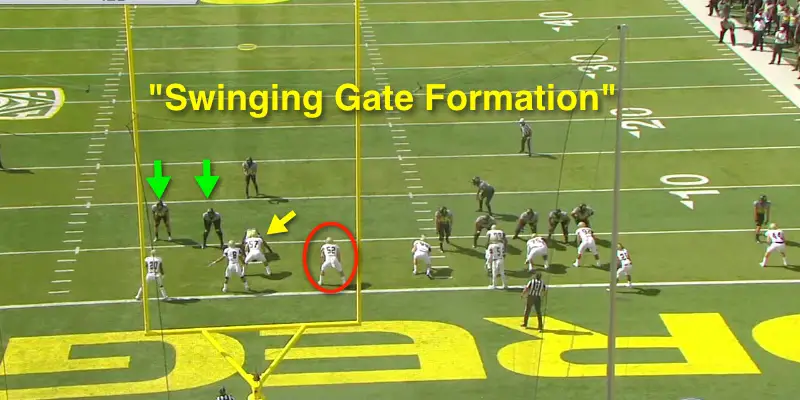As most know, Oregon is known for going for surprise two-point conversions during the usual PAT process. The recent game against UC-Davis provided some superb examples for us to learn what works and why, along with what does not work, and why. While I (Charles Fischer) am writing parts of this article, the primary analysis segments are provided by new coaching consultant Ruskin Fiegenbaum. The whole discussion of tactics the Ducks employed in attacking the perimeter during the PAT is fascinating and will generate more discussion in the future. Let’s get started!
One benefit for the Ducks running these conversion plays? Oregon coaches use these plays to take up limited practice time for every foe they play for the rest of the season. Every opponent now must review, scout and practice stopping this play, even if Oregon does not run it the rest of the year. It’s an advantage because the NCAA allows only a certain amount of time the coaches and players can interact in a given week. More time devoted to this play is less time in other areas (such as stopping Oregon’s offense!).

Seeing this would increase the “Pucker-Factor” for any defender.
In the first conversion attempt (above), Oregon is first looking for an obvious numbers advantage on either side. The Ducks have shifted from the usual PAT formation to a “Swinging Gate” formation that fans have witnessed many times in the past five years. The Aggies have seven defenders to Oregon’s seven players in the “gate,” and four defenders to Oregon’s four players on the other side, as well.
Note that the Ducks have seven players on the LOS, thus the two players with green arrows are eligible receivers, as is the center (yellow arrow), who is the “split end” to the offensive right side (remember the pass to the center against Stanford years ago on a PAT?). Being responsible for these receivers complicates the techniques for the defenders as coming up hard to defend the run can leave them vulnerable to the pass.
The next read above is the leverage or positioning of the defenders in relation to the ball carrier (Charles Nelson, No. 6). The read for Nelson is Davis player No. 52, and you’ll notice how far inside (red circle near the middle of the field) he is compared to the speedy back for Oregon. It is a foot race to the far corner of the end zone between Nelson and No. 52, who is probably an inside linebacker. Oregon has three blockers for three defenders and a head-start for one of their most elusive players against a heavy-footed linebacker in a race to the goal line.
Oregon likes those odds, executes the blocks and Nelson’s ability does the rest. To make matters worse for the Aggies, No. 52 takes a false step inside (slowing him down even further), and the result is an easy conversion for the Ducks.

UC-Davis is adjusting …
The second successful conversion (above) is more of a personnel mismatch than an alignment error. The Aggies shift their linebacker over (red arrow) so he was not out of position from the start of the play.
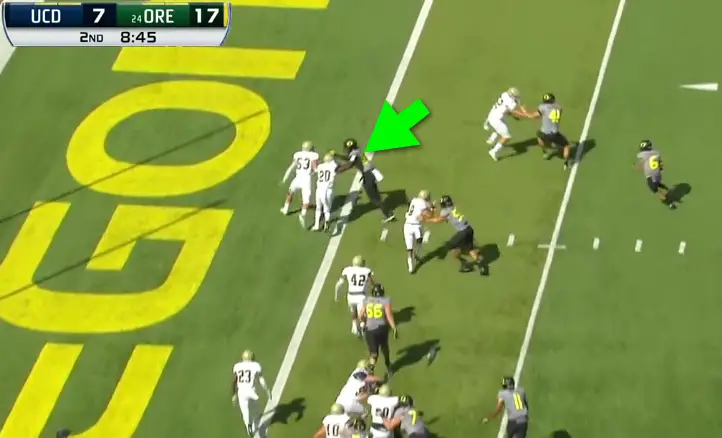
“The Freak” Pharaoh Brown takes on two defenders!
Notice Pharoah Brown, No. 85 (green arrow above), is blocking a defensive back on the LOS and has a huge size advantage. Brown easily blocks his man and in doing so also blocks a second defender (assigned to Nelson) who is again an inside linebacker that has better leverage to start the play, but gets caught behind the block and does not have the speed to catch Nelson.
It is unconventional for the Ducks (above) to go for a second two-point conversion attempt as most coaches (from GOC) will only run one “trick” play per game. Once it is done, they don’t run it again, perhaps for many games. Yet Mark Helfrich is showing that a little of the Chip Kelly stubbornness can pay dividends in future games. His philosophy was that the Ducks would run the two-point play until the opponents adjust to stop it, which is uncommon among the coaching ranks when it comes to gadget-type plays.
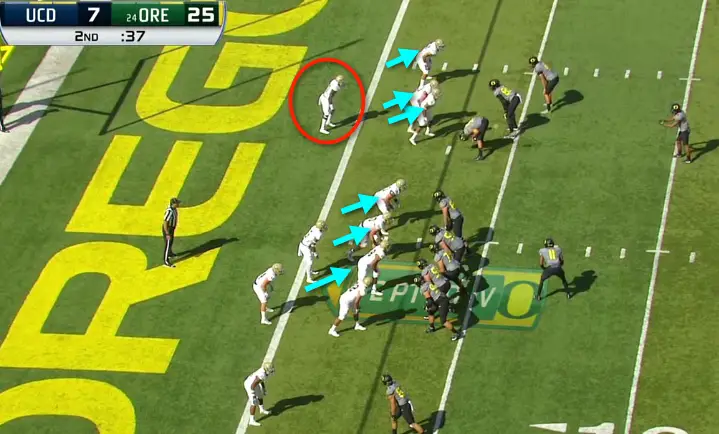
The Aggies were ready this time.
Let’s look at the first failed two-point conversion attempt, and what went wrong. The Aggies finally get proper leverage as they switched from the inside linebacker to a safety (No.20 in red circle above) being assigned to Nelson. He lines up on Nelson’s outside shoulder, so in a race to the end zone he now has a head start on Nelson, unlike the first two attempts. Note how all the defenders are leaning to the outside, as indicated by the light blue arrows above.
Secondly, the Aggies have better equipped personnel on the LOS, who are able to stalemate and “set the edge,” or force the ball carrier to cut back into their unblocked defender. On previous attempts they were either blocked into one another or the unblocked defender was too far out of position to make a tackle on the cutback.
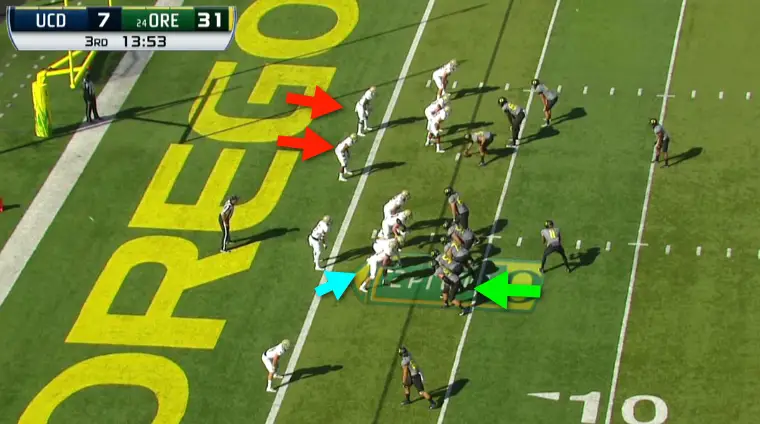
Boy are they loaded up to stop Charles Nelson!
On the fourth attempt (above) – a third successful two-point conversion – the Aggies (see red arrows above) send a fifth defender to Nelson’s side, leaving a five versus six player advantage for Oregon on the side opposite of Nelson. Seeing the Aggies shift an extra man to Nelson’s side of the field, the coaches called a tricky direct snap to the other tailback, Justin Hollins (No. 11), and he took it in for an easy score with a one-man advantage.
Note the leftward leaning again by the Aggies (light blue arrow above), which makes the blocking by the Ducks on that side (green arrow above) that much easier.
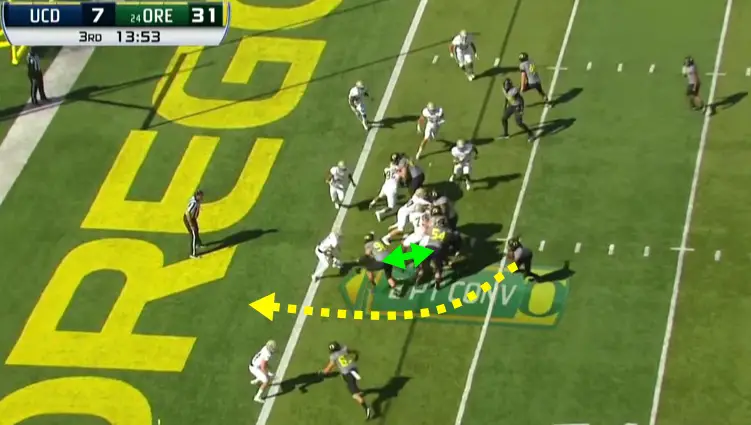
What a wonderful adjustment by Oregon!
It was easy for the Ducks to block “down” or inside, as they easily had “hat-on-hat” blocking. Oregon simply took what the defense gave them, resulting in an easy conversion for Hollins (dotted yellow line above). Note the superb blocks by redshirt freshmen (double-green arrow above) Drayton Carlberg No. 90, and Calvin Throckmorton No. 54.
You can imagine the pressure Oregon places on teams with these plays: one mistake, and Oregon pounces for an extra point on the scoreboard. Not only that, but the mental strain of being pressured on every play – even Special Teams – builds up to create hesitation and errors that Oregon capitalizes on throughout the game.
In the fifth attempt and second failed conversion (above), we see that Oregon shifts from the Swinging Gate-look to the more trading PAT formation, yet the Ducks still go for the two-point conversion. The numbers seem to be in Oregon’s favor but the personnel and surprise factor are not. Oregon has a three- versus two-player advantage to their left side but one of those is a kicker lead blocking, and you cannot count on kickers to take on better athletes in space and win consistently.
The kicker, Aiden Schneider, No. 41 (above), whiffs his block – and the pursuit and force player for UC Davis sandwich Nelson short of the goal line. This play might have worked better if the defense had not been on alert from the previous four attempts. Oregon had certainly lost its element of surprise that usually exists on a PAT fake.
We usually only show three examples in an analysis, but we felt more learning could come from plays that don’t work, thus helping our understanding of the results of two-point conversion attempts in the future.
Oregon has opened the door to numerous other variations that can come from the same Swinging Gate formation. Thus, this discussion helps lay a foundation for understanding the entertaining options we inevitably will see over the next three months.
“Oh how we love to learn about our beloved Ducks!”
Ruskin Fiegenbaum
College Football Analyst for FishDuck.com
Portland, Oregon
Top Photo from Video
Ruskin has been following the Ducks since the ’94 Rose Bowl. He graduated from the University of Oregon in 2007 and has been coaching football in the Portland-Metro area since 2008.

